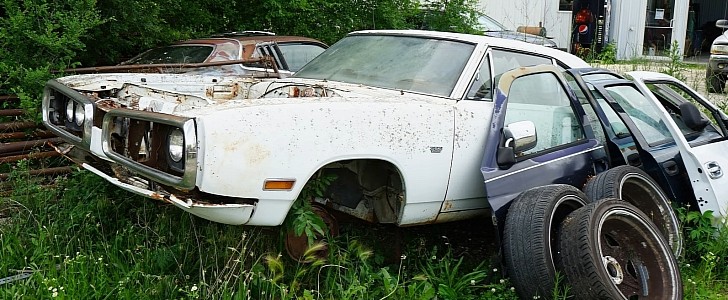Introduced in 1968 as Dodge's low-priced competitor to the Plymouth Road Runner, the Super Bee remained in production for only four model years. But even though it was the brand's most affordable muscle car, it wasn't particularly popular.
Dodge sold only 7,842 units in 1968. And even though deliveries grew to a more impressive 27,800 examples in 1969, they dropped to about 15,500 in 1970. For its final year, when it was based on the Charger instead of the Coronet, the Super Bee moved only 5,054.
As a result, it's one of the rarest nameplates produced during the golden muscle car era. What's more, the Super Bee is also among the rarest HEMI-equipped classics.
That's because only 355 customers ordered the muscle car with the mighty 426-cubic-inch (7.0-liter) V8. And yes, I'm talking about 355 cars sold across four model years. And needless to say, they're quite expensive in 2022, fetching six-figure sums when in Excellent condition and with numbers-matching engines.
The 1970 Super Bee you're about to see below is not one of those impossible-to-find HEMIs (only 42 built), but it's not exactly common either. Because this specific Mopar is a post car (coupe), which isn't as common as the hardtop version. Of the 15,506 Super Bees built in 1970, only 3,630 were coupes, according to the Super Bee Registry.
What's more, the 383-cubic-inch (6.3-liter) V8 engine and the automatic transmission narrow it down to only 1,710 units. Then there's the white exterior / blue interior combo that likely makes this Super Bee one of fewer than 50 made, but there are no official records based on color combinations.
However, the Super Bee Registry includes only 12 383 V8 cars in white as of this writing, and only eight of them have automatic gearboxes.
Numbers aside, this 1970 Super Bee is in pretty rough shape. The paint has seen better days, the interior is just as weathered, and the engine is missing. But that's because this Mopar has been off the road for a few decades.
YouTube's "Auto Archaeology" has been documenting it for almost 20 years, but this Super Bee has been sitting for longer than that. Based on the info he got from one guy at the yard, the muscle car spent some 40 years waiting for a second chance.
Well, I think it actually looks better than it should, given that it sat outside, fully exposed to the elements, for so many years, but that's not the best news surrounding this classic. This Super Bee will get restored.
The owner recently expanded his shop and finished restoring other cars he had sitting around, including a Plymouth Superbird, and this Super Bee is on the shortlist for an overhaul. It would all be perfect if the original 383 V8 would be around (there's no info on whether it survived or not), but that's still great news. And hopefully, we'll see this Superbird up and running soon enough.
As a result, it's one of the rarest nameplates produced during the golden muscle car era. What's more, the Super Bee is also among the rarest HEMI-equipped classics.
That's because only 355 customers ordered the muscle car with the mighty 426-cubic-inch (7.0-liter) V8. And yes, I'm talking about 355 cars sold across four model years. And needless to say, they're quite expensive in 2022, fetching six-figure sums when in Excellent condition and with numbers-matching engines.
The 1970 Super Bee you're about to see below is not one of those impossible-to-find HEMIs (only 42 built), but it's not exactly common either. Because this specific Mopar is a post car (coupe), which isn't as common as the hardtop version. Of the 15,506 Super Bees built in 1970, only 3,630 were coupes, according to the Super Bee Registry.
What's more, the 383-cubic-inch (6.3-liter) V8 engine and the automatic transmission narrow it down to only 1,710 units. Then there's the white exterior / blue interior combo that likely makes this Super Bee one of fewer than 50 made, but there are no official records based on color combinations.
However, the Super Bee Registry includes only 12 383 V8 cars in white as of this writing, and only eight of them have automatic gearboxes.
Numbers aside, this 1970 Super Bee is in pretty rough shape. The paint has seen better days, the interior is just as weathered, and the engine is missing. But that's because this Mopar has been off the road for a few decades.
YouTube's "Auto Archaeology" has been documenting it for almost 20 years, but this Super Bee has been sitting for longer than that. Based on the info he got from one guy at the yard, the muscle car spent some 40 years waiting for a second chance.
Well, I think it actually looks better than it should, given that it sat outside, fully exposed to the elements, for so many years, but that's not the best news surrounding this classic. This Super Bee will get restored.
The owner recently expanded his shop and finished restoring other cars he had sitting around, including a Plymouth Superbird, and this Super Bee is on the shortlist for an overhaul. It would all be perfect if the original 383 V8 would be around (there's no info on whether it survived or not), but that's still great news. And hopefully, we'll see this Superbird up and running soon enough.







